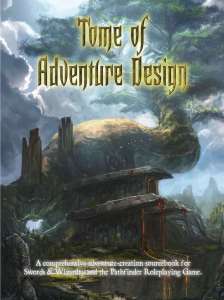The best dungeons build on the three Dungeons & Dragons pillars of combat, roleplaying interaction, and exploration—a pillar that depends on discovery. Dungeon creators rarely slight two of the pillars: Monsters engage characters in combat. Non-player characters and factions lead to roleplaying interaction. But for the last pillar of exploration and discovery, dungeon designers often stop at the map, and that counts as neglect. Interacting with a floor plan gets tiresome fast.
To engage players in exploration and discovery, dungeons need more than listings of rooms and inhabitants where characters open a door and discover their next opponent.
 Typically, dungeons also feature a history as a tomb, wizard’s tower, cursed underground city, or the like. But while such themes add flavor, this mere color rarely includes enough discoveries to capture hours of attention. Dungeons need interactive features that give players the underrated pleasure of figuring things out, of trying things and discovering how the dungeon and its contents work.
Typically, dungeons also feature a history as a tomb, wizard’s tower, cursed underground city, or the like. But while such themes add flavor, this mere color rarely includes enough discoveries to capture hours of attention. Dungeons need interactive features that give players the underrated pleasure of figuring things out, of trying things and discovering how the dungeon and its contents work.
The fun of exploring a tomb comes from interacting with the traps, puzzling inscriptions, and blessed shrines inside. The fun of a wizard’s tower comes from playing with the magical whimsy and the experiments gone wrong. The fun of lost city comes from the magic fountains, secret ways, and so on.
Whatever the location, dungeons need interactive features that characters can play with like toys, things that fire the player’s curiosity, and then invite the players to touch and experiment. Sometimes the toys might prove dangerous, other times they can reward with treasure, blessings, or useful information, but players who discover how something operates always feel rewarded for their brains and ingenuity. Good exploration leads to the powerful reward of such discoveries.
Adventure designer M.T. Black writes, “Adventures thrive on interactivity. Without it games become uninteresting. This is a big part of the exploration pillar of play, and I think it is neglected. Pick up the diary and it grows legs. Touch the holy orb in the chapel and a glass knight steps out of the window. The treasury looks empty but actually has an invisible treasure chest.”
When I first started creating dungeons, I aimed to pack my locations with the sort of lavish, interactive rooms in adventures like the Tomb of Horrors and White Plume Mountain. Preparing for a single session took me hours of dreaming up elaborate locations that could confound and impress my players. I soon learned that I lacked the time to invest in so many detailed designs. Later, I found that I didn’t need to, because smaller, simpler toys can work as well. Every parent has unpacked and assembled an extravagent toy, only to see their kids become captivated by the box. Many players like me also become captivated by the boxes—or pools, orbs, runes, statues, and so on. All those things prove fun as long as playing rewards us with discoveries.
Now when I design dungeons, I focus on including things that both invite interaction and lead to discoveries. So, the pool might include and underwater passage that leads to another room. Or it might contain acid and a glass vial containing a map to a secret treasure room. Or it might bubble with fumes that make characters lightheaded enough to see a vision of a similar room elsewhere. The best toys often mix danger and reward, so those fumes might make characters fall unconscious, and then see visions as they start to drown. Surely someone in the party will save their dreaming friend.
Dungeons packed with such features feel like more than maps with monsters, they feel like toys that reward play with discovery.
Related: To Find the Fun in Traps, Did D&D Miss the Search Check?









 Instead, we add dice.
Instead, we add dice. For the DMs Guild adventure
For the DMs Guild adventure 
 Elsewhere, an incubus seeking the shield makes an entertaining foil for the party. “Trait. I enjoy shapeshifting often while talking to mortals, as it annoys them.” The adventure suggests some amusing shapes to take.
Elsewhere, an incubus seeking the shield makes an entertaining foil for the party. “Trait. I enjoy shapeshifting often while talking to mortals, as it annoys them.” The adventure suggests some amusing shapes to take.